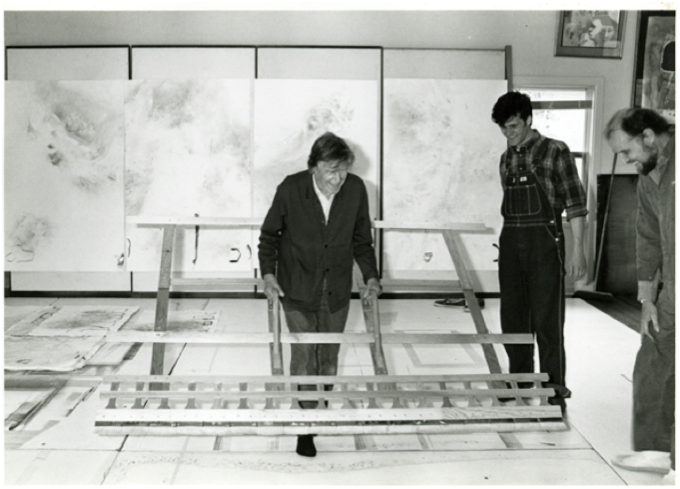RAY KASS: JOHN CAGE’S WATERCOLOR PAINTINGS
As a part of the John Cage Centennial Festival Washington, DC, Ray Kass, and members of the Mountain Lake Workshop, will present an extraordinary day of activity in the University of California’s Washington Center. Two watercolor workshops will be held (morning and afternoon) on September 10, 2012. One will be directed at interested adults, the other at Washington area high school students. The evening features two live performances of the very late Cage work, STEPS (see below), and visual documentation of a Merce Cunningham performance of this work ("danced" from a wheelchair). A question period will conclude the day. We are confident that this unique set of events will bring the larger Festival to an engaging and provocative completion.
In 1983, as a result of his pleasure with the experience he had in producing etchings at the Crown Point Press in California’s Bay Area, and the informed encouragement of artist and author Ray Kass, John Cage began work on a series of watercolor paintings at the Mountain Lake Workshop. Over the course of four visits to the Workshop in the Appalachian region of southwestern Virginia (1983, 1988, 89, and 90), he produced 125 documented watercolor paintings.
 A river rock guides a feather brush.
A river rock guides a feather brush.
Published here by permission, Ray Kass
Cage’s productivity in the domain of visual art – etchings, drawings, watercolors – embraces and engages with the strategic scope of his larger aesthetic stance and the impact of ego-distancing “chance” procedures. The ways in which Cage chose materials and boundary conditions in his visual art allow us to gain insight into the aesthetic predilections of his eye in strikingly revealing fashion.
Ray Kass and others associated with the Mountain Lake Workshop were inventive, and ultimately very successful in encouraging Cage’s engagement with what was for him a new medium. What began as a limited exploration evolved during subsequent working periods, towards increasingly complex and elaborate projects.
The largest of Cage’s watercolor paintings involved a 56-inch wide, specially constructed brush. This device was “loaded” by means of an even wider wooden trough that contained the ink. In performing what eventually became John Cage’s STEPS: A Composition for a Painting to be Performed by Individuals and Groups, Cage was required to dip the enormous brush into the ink trough, then step from two pans of black ink onto a vast expanse of paper, and walk backwards, pulling the brush over the imprints left by his feet. Various other individuals have subsequently realized STEPS (as Cage envisioned). Notably, dancer Merce Cunningham (participating with the inked wheels of his wheelchair) who also choreographed three versions with members of his dance company. – Roger Reynolds

John Cage delightedly assuming command of a custom-built brush. John Cage, Peter Lau, and Ray Kass.
Published here by permission, Ray Kass and Virginia Tech Photographic Services
PLEASE NOTE: Ray Kass’ recently-published The Sight of Silence: John Cage’s Complete Watercolors, provides an engaging picture of the visual aspect of the composer-artist’s work, including elegant, meticulous documentation that allows the reader to gain a beautifully textured proximity to Cage’s working environment and processe.

|